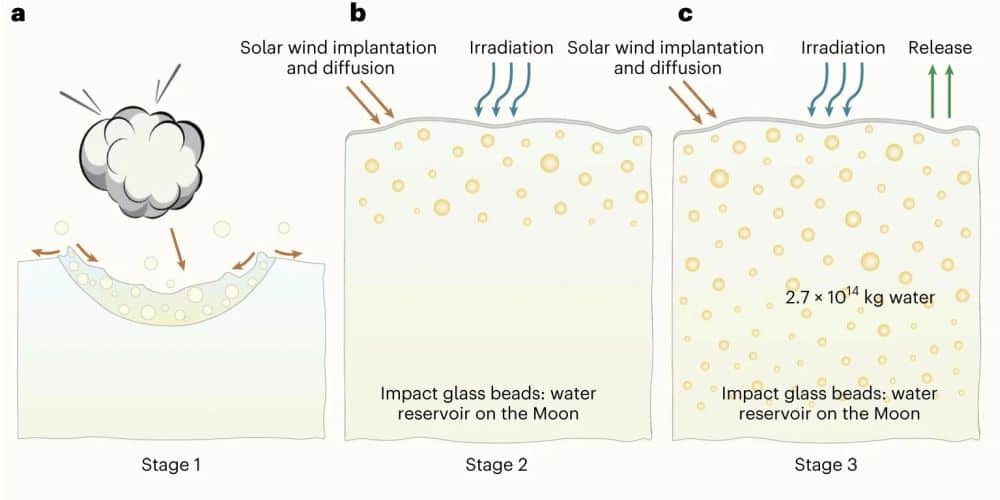
[Image above] A full moon rises over the mountains of Norway. As humans prepare to travel back to the moon, they will need to develop technologies that can create or extract necessary resources from the local space environment. Credit: James Losey, Flickr (CC BY-NC-SA 2.0)
Space historically is a place only a few select individuals will ever visit, after being chosen and intensely trained through government-run space programs. However, more and more private companies—such as Sierra Space, our Ceramic Tech Chat podcast guest this month—are starting to enter the space sector. Their immediate plans for commercializing space will ultimately have the broader impact of helping make space a more accessible destination.
Yet as more people enter space—and perhaps someday establish long-term outposts on other celestial bodies—ensuring they have all the necessary supplies for survival will be a major challenge.
Including all essential resources on the spacecraft is not feasible from both a cost and survival perspective. Launching such a heavy payload would require an enormous amount of fuel, and the crew would have no way to replace supplies that run out or are damaged.
Instead, researchers are actively developing in situ resource utilization (ISRU) technologies. ISRU technologies allow necessary resources to be created at the destination or along the way. Such technology overcomes the need to bring all required supplies along from the start, and it allows people to replace essential resources while in space.
3D printing parts out of lunar regolith and extracting oxygen from a planet’s atmosphere are two examples of ISRU technologies that make use of the local space environment. Now, new data gathered during a recent Chinese lunar exploration mission provides more insight on another essential resource that can be accessed locally on the moon—water.
Even before humans first landed on the moon in 1969, scientists suspected there may be water lurking somewhere on the celestial body. In 1998, a neutron spectrometer on board NASA’s Lunar Prospector mission confirmed the existence of ice at the lunar poles.
Other missions during the past two decades provided further confirmation of water on the moon. Yet “the origin(s) of this lunar surface water and its spatial distribution and evolution during regolith gardening remain largely unknown, despite key implications for future lunar surface exploration,” researchers write in an open-access paper.
The researchers come from numerous state laboratories and universities in China. In their paper, they explain that the solar wind is generally believed to play a major role in the presence of water on the moon.
The solar wind is a continuous stream of charged particles released from the sun that permeates the solar system. When these charged particles reach the lunar surface, they interact with other atoms—particularly oxygen—to produce hydroxyl or water in lunar soils. Researchers suspect this water then migrates to polar regions, driven by temperature oscillations.
For this theorized water cycle to be sustained, there would need to be a hydrated layer (reservoir) below the lunar surface.
“However, finding this water reservoir has remained elusive … [and consequently] there must be a yet-unidentified water reservoir in lunar soils that has the capacity to buffer a lunar surface water cycle,” the researchers write.
In 2020, China launched Chang’e 5, the fifth lunar exploration mission of the Chinese Lunar Exploration Program and the country’s first lunar sample-return mission. The Chang’e 5 spacecraft successfully returned about 3.8 pounds (1.7 kg) of lunar samples back to Earth. The samples were notably “young”—less than 2.0 billion years old—compared to the NASA Apollo samples, which were 3.1–4.4 billion years old.
Included in the lunar samples were impact glass beads, or tiny glass spheres that form when asteroids or other impactors smash into the moon. Water can accumulate within these glass beads like a sponge, and thus the beads are potential candidates for playing a significant role in the lunar surface water cycle. Yet “the water inventory of impact glass beads has not yet been investigated in detail,” the researchers write.
The researchers carried out a systematic characterization of the petrography, major element composition, Raman characteristics, water abundance, and hydrogen isotope composition of 32 impact glass beads.
Their analysis showed that water retained within the impact glass beads originated from the solar wind. This finding supports the theory that solar wind is the main source of water on the moon, in contrast to other potential lunar water sources, such as lunar volcanism or carbonaceous chondrites.
The researchers then proposed a model to explain the potential role of impact glass beads in the lunar surface water cycle, as illustrated below.

The researchers estimate there to be 3–27 trillion kg of water held by impact glass beads in lunar soils. This water, which they believe could be easily extracted through a heating process to release vapor, provides “a much higher amount of solar wind-derived water than previously thought, which could be a water reservoir for in situ utilization in future lunar exploration,” they write.
The open-access paper, published in Nature Geoscience, is “A solar wind-derived water reservoir on the Moon hosted by impact glass beads” (DOI: 10.1038/s41561-023-01159-6).
